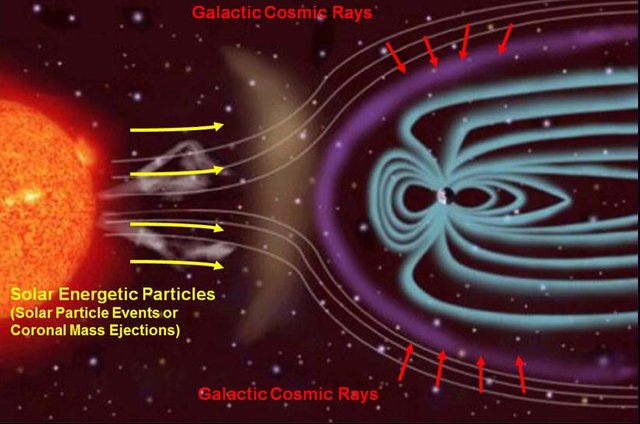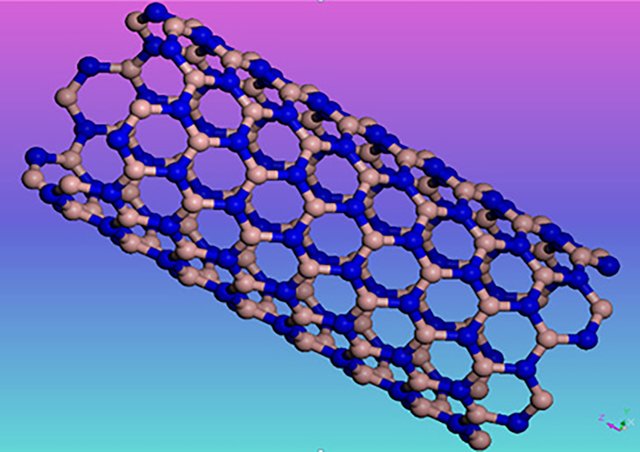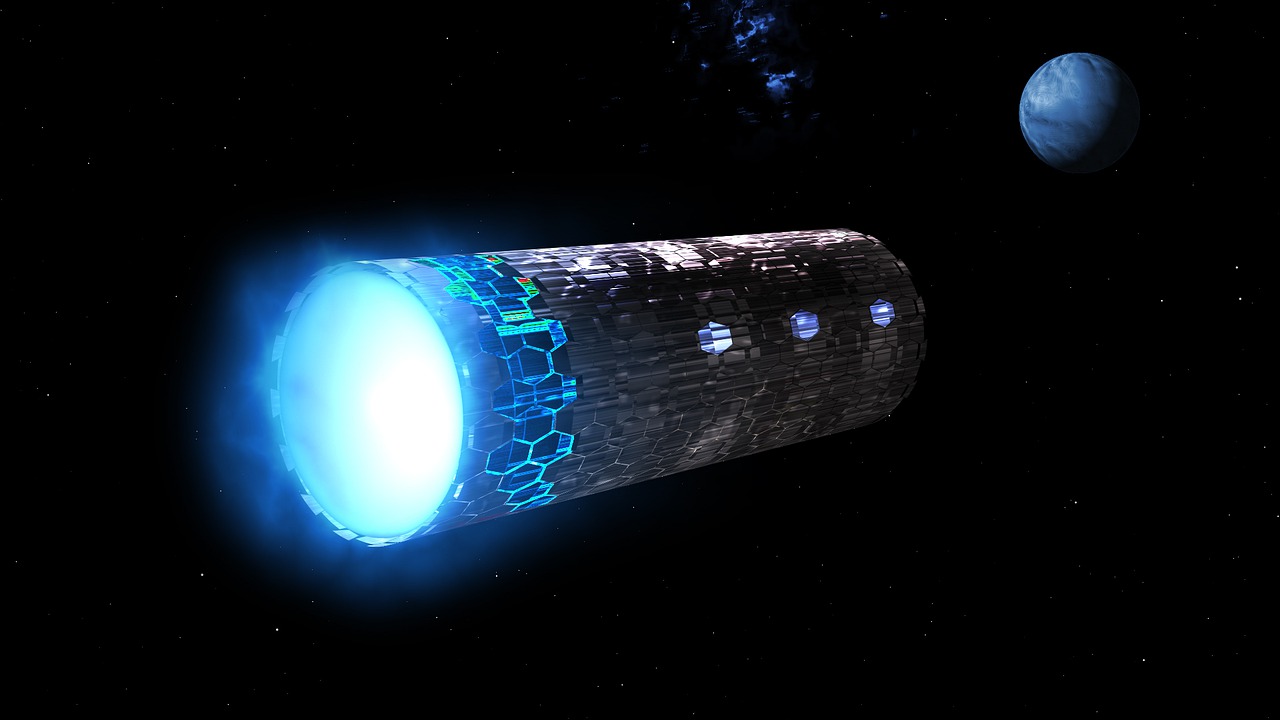Radiation on our way to and on MARS - Colonization of MARS Series
Continuing my easy to read in-depth series about the science behind the future colonization of Mars.
Using my space and physics knowledge to craft a Colonization Handbook using the last studies available.
Quick definitions and types of Radiation
Radiation is the emission/transmission of energy as subatomic particles or electromagnetic waves through space. It is especially used to define the energy emitted by ionizing high-energy particles.
It can be ionizing and non-ionizing, the ionizing radiation being the most disruptive to living tissue, due to carrying more than 10eV (electron-volt), which can break chemical bonds. Radioactive materials emit α (alpha), β (beta), or γ (gamma) radiation. We will focus more on the ionizing radiation, as this type of radiation can cause the most harm when travelling in space. This radiation is under no way felt by the human senses, until it it too late and it has already caused its disruptive effects to the body. While usually α (alpha) or β (beta) rays are typically stopped by any type of obstruction, the γ (gamma) rays have much more speed and mass to even penetrate lead.
I could talk about radiation in detail, perhaps I will, as I didn't find any complete (or acceptable by my standards) articles about this on the blockchain at a fast glance. If you do find such an article,please tell me and I will add a link to it here.
The radiation dosage can be instantaneous or over a longer period of time. Both have their own disadvantages but the body can absorb a larger dose of radiation over a long period of time without being disrupted. Even living on Earth exposes us to some types of radiation and our bones and marrow even have trace radioactive elements. This is called background radiation and Wikipedia offers us a simple comparison between the natural and artificial exposure.
A sievert (Sv) is an International System of Units approved means of measuring the health effects of ionizing radiation.

What about without the protection of our atmosphere?
As far as we know from data recovered from the space programs, we are less protected in outer space than under the atmosphere. This also includes the Martian Atmosphere which is thin and powerless in the face of powerful cosmic rays. Since the Martian colony will be better protected than the spacecraft taking us there I will focus on material and ways to shield the spacecrafts while in transit, protection on the planet will be much easier. The astronauts on the Apollo mission got 1.2 mSv/day and the Skylab mission got 1.4mSv/day. For the ISS, due to better materials and the fact that missions are longer, the intake was reduced to only ~0.40mSv/day. And we will see if we can reduce this figure even lower for Mars travel or during other types of Martian missions.
Again, I am not going to get into more details about dosage, limits and fatal doses because hopefully we don't want to go anywhere near those doses on a standard Mars mission. We are going to see what we are up against and what are some of the challenges of living and traveling to Mars and see if the new research can do anything to minimize the risks and intakes.

What is space radiation?
Apart from the particles still inside the Earth's magnetic field that are close to the planet (including those in the Van Allen belt) and the expulsions from the common solar flares or solar storms, the main danger is that of the cosmic rays. While the smaller particles can be easily stopped by simple materials, because of the mass and speed of the particles in cosmic rays, a different approach must be taken to ensure crew protection.
 NASA's Radiation Assessment Detector aboard the Curiosity Rover investigated the magnetosphere and radiations.Source
NASA's Radiation Assessment Detector aboard the Curiosity Rover investigated the magnetosphere and radiations.Source
You can also take the time to follow Curious Droid's in-depth explanation. I am following him for a very long time and he produces a lot of high-quality videos about space, narrated and explained in a simple way. Great for listening to while I am doing simple, repetitive tasks during my job.
A cosmic ray is made out of heavier elements with huge levels of energy and speed, being created in other galaxies during certain events. Because they travel at the speed of light and suffer a lot of interactions along the way, they have completely lost their electrons, only retaining their nuclei. This causes a high level of ionization when they pass through virtually anything, due to their mass and speed. Almost all of the particles are of well known atoms like hydrogen and helium and some are of very heavy elements. A negligible part consists of antimatter. We will focus on how to protect from the most common. Just as a mention though, some of the high energy cosmic rays have the kinetic energy of golf balls or even baseballs, and imagine that a spacecraft is built from very light materials, not capable of withstanding such a shock, so other techniques must be used.
Additionally, when we will venture outside of our solar system we will have to consider withstanding an even greater amount of radiation as the Termination Shock and Heliosheath around ends and interstellar space starts as the Sun protects us from the particles.

Basic spacecraft shielding
The materials used in the radiation protective shielding following the primary studies from the 60's till the 90's or early 2000's consisted of mainly aluminium, being also very light and augmented with polyethylene, in a sandwich-like layerered composite. The main idea is to slow down the initial particles in the first layer and capture them in the subsequent layers, this being much more effective than a single thick layer. Further studies have shown the shielding properties of hydrogen fuel or water. Designs using a thin encompassing layer around the habitation modules could prove useful in reducing the doses.
Another huge problem of efficient spacecraft shielding is the fact that high speed particles traveling at the speed of light could be slowed down to just under the speed of penetration by the last layer of the shield on their into the spacecraft, effectively trapping them inside with the astronauts. Their speed will decay in time, but this will still take a few bounces inside the spacecraft. Some researchers estimate that up to 50% of a possible astronaut radiation dose will be delivered this way, although the estimates are just theoretical, without a case study in place. Further research is being done in this field.

Comparison of materials of the same thickness in regard to GCR ( galatic cosmic rays). Source

Active spacecraft shielding AKA Energy Shields
Another layer of protection besides the basic shielding comes from Electrostatic Fields or Confined or Unconfined Magnetic Fields or Plasma Shielding.
A study about these types of shielding found out that we need more studies to cover GCR ( Galactic cosmic rays) and HZE ( heavy ions). This is in part due to the erratic funding of the space program and the lack of interest for deep space missions or colonizations.
Thus, the electrostatic shield need to be at least 10 times bigger than the state of the art shields we can produce and although new research is surfacing in the last years we are still pretty far from fully encompassing a ship of a hundred meters in an efficient way.
What about the Plasma Shielding? Using an electrostatic field to repel the heavy particles. According to the aforementioned study, a two tier shield to deflect cosmic rays would achieve an electrostatic potential of 200000kV and could be faced with instabilities in the plasma cloud and would not protect against HZE. Not to take into account the 12 MJ that would be stored in the plasma. Moving on to other possibilities.
Magnetic Field Shielding: probably the best option is the use of torus magnets or wires placed in the external shell of the spacecraft. This will reduce the field to only a small area outside of the spacecraft and might require less power to function. This would be effective against SPE (solar particle effects or solar flares) but not much help against GCR. By balancing the use of materials some basic protection from both GCR and SPE could be achieved. Not impressive but better than the previous research.
In the study of Paluszek that I could only get a reference to in another study available here, back in 1978 ( yes, I know, we desperately need more space scientists) a shield that would protect a colony ship with a 100 meters diameter would weight around 1 million metric tons.
Add the manufacturing issues and the ability to launch such a shield to space and the tasks grow in magnitude easily.
With the space programs having made it to the private sector, we could expect a lot more funds to be poured into the research and even better researchers assigned to these tasks. The upcoming studies should provide more info on this. Elon Musk was asked in a Reddit Ask me Anything session about his upcoming Mars Vehicle, the BFR and he has stated that it will not use any active shielding and passive shielding will only be thicker in the habitation parts of the ship. He gave the example of Buzz Aldrin who had a very active space career and he is 87 years old and healthy. Not exactly science, because each person's body responds and absorbs radiation in different ways.
The BFR will use methane, I have explained in my previous articles why that is better than LOX for Mars Missions, so by looking at its composition (25.1% hydrogen vs 11.2% of the water) this would make it a better shield than water. I would avoid to be encompassed in a thin cover of methane for 6 months though but the aviation industry also had this problem of very flammable fuel and it solved it with technology.

Future research
Many other approaches are being taken, including reducing the travel time, pharmaceutical countermeasures and personal and operational dosimeters like the Hybrid Electronic Radiation Assessor. NASA's Human Research Program was started just to find solutions and technologies in order to safely deliver astronauts to their destinations.
NASA is actively improving the shielding materials, trying to find better materials. One of the most promising is Hydrogenated BNNT's, small tubes with a diameter measured in nano-meters ( that's one billionths of a meter or 1×10−9 m). These tubes made out of Boron, Carbon, Nitrogen and Hydrogen, absorb or shield other neutrons found in HZE.
 Long, highly crystalline boron nitride nanotubes (BNNT), developed by The NASA Langley Research Center (LaRC), Jefferson National Lab (JNL), and National Institute of Aerospace (NIA)
Long, highly crystalline boron nitride nanotubes (BNNT), developed by The NASA Langley Research Center (LaRC), Jefferson National Lab (JNL), and National Institute of Aerospace (NIA)
They hope to weave it into spacesuits and stitch the external protection layers of the spacecraft with it. We will have to keep an eye on the science and see what further research might bring us in terms of improvements.

What about Mars?
Mars is already more protected as I was saying in the beginning of the article. The same techniques could be applied and the colony could be underground, either by using boring mechanisms or by using robots to cover all the colony in regolith. Another approach is to search for lava tubes and settle there, far from any external radiation. I will talk about the psychological implications in a further article but there are ways to accomplish this. Space suits will offer sufficient protection for surface missions and better shielded modules could reside on the surface.
Conclusions
The science is still not yet there in terms of full radiation protection. It will be no doubt more dangerous to venture into space than living on Earth but slowly, the research is turning up more results. I am a little disappointed by the lack of research here and the overall results. Again I feel the need for more and better scientists working in this field to maintain a steady flow of studies and advancements. So if you are a physics student, don't wait for further invitations, just help us get there already :D

Additional sources:
http://thayer.dartmouth.edu/~d76205x/research/Shielding/docs/Townsend_00.pdf https://www.ge.infn.it/~geant4/papers/chep2000/pap-a123.pdf https://www.nasa.gov/feature/goddard/real-martians-how-to-protect-astronauts-from-space-radiation-on-mars https://www.nasa.gov/hrp https://www.nasa.gov/sites/default/files/atoms/files/niac_2011_phasei_thibeault_radiationshieldingmaterials_tagged.pdf https://www.youtube.com/channel/UC726J5A0LLFRxQ0SZqr2mYQ - Curious Droid's Youtube channel.





Hi, I found some acronyms/abbreviations in this post. This is how they expand:
Another great post.
Unlike our own planet, Mars doesn't have the same internal dynamo in its core that generates a magnetic field, which means Mars is pretty defenseless from cosmic rays. That same field protects Earth's atmosphere from being stripped away by solar winds. Mars used to have a magnetic field, but after it deteriorated, most of the atmosphere was stripped away. Here is Mars' magnetosphere visualized and compared to Earth's.

It's basically non-existent.
It might sound scary, but our bodies are used to low levels of radiation. We have error correcting mechanisms that fix DNA and cells that repair. It's intense high level radiation that's dangerous because it overwhelms these processes and can cause morbidity rapidly.
Welcome back you were out for a while.
Thanks for adding that to the article. I would say that colonizing the whole surface of Mars is not needed, but who knows how our technology will evolve. Maybe people will actually want to live there, in which case we will eventually need to find a way to kickstart its core :)
Day job got in the way of my steemit double life :D
I found an article on nautil.us where an interesting idea is proposed. If we create a large magnetic field at Lagrange point L1, between Mars and the Sun, we create a magnetic tail that would shield Mars from solar winds. That way we wouldn't even need to somehow figure out how to jump start the core again. Mars' atmosphere would be saved. However, this wouldn't protect Mars from cosmic rays that originate from outside our solar system and bad boys like the aptly named Oh-My-God particle.
What a cool idea! Solar winds are the biggest problem of Mars so yes, it would actually fix a lot. I will read it.
Human explorers to Mars will definitely need to deal with the increased radiation levels on the surface.great finding
I am really hoping that more research will be available by the time it's scheduled ( 2022-2024).
I did R&D for some spacecraft that MIGHT go to Mars, probably a better version of it by then. Radiation is a huge issue not just in the realm of materials science.
We will need huge leaps in technology to get there.
This is where one realizes Musk doesn't really know what he is talking about.
I am not sure that Musk is very far from what NASA says. We will have to wait and see how his BFR will do.
Until now he delivered, one way or another. What spacecraft are you talking about?
Again, I just don't see his timelines being possible unless he holds secret knowledge.
Hey @alexdory, I really enjoyed reading this article. I'm fascinated by astronomy but I really don't have much knowledge. I find this article very explicitly written.
It is my first time of seeing the unit "sievert". I will like to know the limit the human body can take before the effects begins to manifest. Although you mentioned that different people react to radiation in different ways, but there should be some range of values, which when attained becomes unacceptable.
Of course:
The sievert is the special name for the SI unit of equivalent dose, effective dose, and operational dose quantities. The unit is joule per kilogram.
PBS has an interesting chart regarding that:

I grew up too close to Chernobyl and I was born right when it happened.
Please mind the "using a cellphone does not produce ionizing radiation* and does not cause cancer".
*unless it's a bananaphone :)
Funny actually
That's serious. The chernobyl accident is the most disastrous of all nuclear explosion in history.
I hope you are fine? Considering that you were born around that time and in that vicinity.
Yes, my mother is a medical doctor. I got a sufficient intake of Iodine so that my body would not try to absorb any from the atmosphere. It is one of the most easily absorbed radioactive substances but also one of the fastest to decay. It was not deemed very dangerous. Romania is the fish-shaped country right above the cursor in the beginning.
Congratulations @alexdory! You have completed some achievement on Steemit and have been rewarded with new badge(s) :
Click on any badge to view your own Board of Honor on SteemitBoard.
To support your work, I also upvoted your post!
For more information about SteemitBoard, click here
If you no longer want to receive notifications, reply to this comment with the word
STOPDo not miss the last announcement from @steemitboard!
we have to pay for expensive trips into space, not only money but also our health.
all of which will produce end-rewarding results, albeit full of risk, human curiosity finally overcame the fear of all bad risks, we are not too late to realize it. with the rapidly evolving technology is only a matter of time for us to reduce or perhaps eliminate all the bad things there.
I totally agree. Plus, we now have technology on our side. The first colonists in America did the same, they risked and many lost, but we still colonized it.
Great mentality, I love it!
thank you for sharing good post!
Being A SteemStem Member